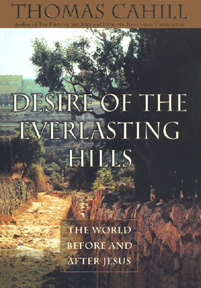Multimedia Reference Religion Travel |
 Desire of the Everlasting Hills: The World Before and After Jesus Thomas Cahill
Description From The Publisher: A Book-of-the-Month Club Main Selection At the heart of Thomas Cahill's Hinges of History series is the ambition "to retell the story of the Western world as the story of great gift-givers." In Desire of the Everlasting Hills, with the same lively narration and irresistible perceptions that characterize the first two volumes, Cahill illuminates the essential role of the man taken by so many to be the central figure of Western civilization: Jesus of Nazareth. Cahill begins with the social and political context into which Jesus was born by introducing "the people Jesus knew," showing that to understand Jesus the oppressive Roman political presence, the pervasive Greek cultural influence, and especially the widely varied social and religious context of the Judaism in which Jesus moved and flourished must be understood. Cahill then gives a shrewd and original interpretation of the New Testament that will delight readers and even surprise biblical scholars Cahill's most unusual skill may lie in his ability to bring to life people of a faraway world whose concerns seem at first to be utterly removed from the present day. His portrait of Jesus evokes a real person, sharp-witted and sharp-tongued, but kind, humorous, and affectionate, shadowed by the inevitable climax of crucifixion, the cruelest form of execution ever devised by humankind. Mary, while not the "perpetual virgin" of popular piety, is a vivid presence and forceful influence on her son. The apostle Paul, the carrier of Jesus' message and most important figure in the early Jesus movement (which became Christianity), finds rehabilitation in Cahill's astonishing portrayal of him as "the first person in history to...believe nothing not birth, nor ethnicity, nor economic status, nor class, nor gendermakes anyone better that any one else." This is a book for Jews and Christians, believers and agnostics, an interpretive history that invites readers into an ancient world to commune with some of the most influential people who ever lived. Reviews "With grace, skill, and erudition, Cahill summarizes obtuse semantic and historical arguments, highlights the findings most relevant to lay readers and draws disparate materials together in his portraits of Jesus, his mother, Mary, and the apostle Paul." Washington Post "Desire of the Everlasting Hills imparts gratifying dimension to the beginnings of what later became known as Christianity. Most important, it makes of Jesus a still-living literary presence." New York Times "Each of his books also offers moments of genuine insight into the workings of culture, literature, and the human heart....For a book about Jesus and the early Christians, Desire of the Everlasting Hills is itself a gift." Commonweal "Cahill's ability to bring life to people of a faraway world ensures that this book will be an interpretive history accessible to believers and non-believers alike." Los Angeles Times
Reader's Index Send us your favorite quotes or passages from this book. About the Author Thomas Cahill is the author of the best-selling books, How the Irish Saved Civilization: The Untold Story of Ireland 's Heroic Role from the Fall of Rome to the Rise of Medieval Europe, The Gifts of the Jews: How a Tribe of Desert Nomads Changed the Way Everyone Thinks and Feels, and Desire of the Everlasting Hills: The World Before and After Jesus. These books comprise the first three volumes of a prospective seven-volume series entitled "The Hinges of History," in which Cahill recounts formative moments in Western civilization. In "The Hinges of History," Thomas Cahill endeavors to retell the story of the Western World through little-known stories of the great gift-givers, people who contributed immensely to Western, culture and the evolution of Western sensibility, thus revealing how we have become the people we are and why we think and feel the way we do today. Thomas Cahill is best known, in his books and lectures, for taking on a broad scope of complex history and distilling it into accessible, instructive, and entertaining narrative. His lively, engaging writing animates cultures that existed up to five millennia ago, revealing the lives of his principal characters with refreshing insight and joy. He writes history, not in its usual terms of war and catastrophe, but as "narratives of grace, the recountings of those blessed and inexplicable moments when someone did something for someone else, saved a life, bestowed a gift, gave something beyond what was required by circumstance." Unlike all too many history lessons, a Thomas Cahill history book or speech is impossible to forget. He has taught at Queens College, Fordham University and Seton Hall University, served as the North American education correspondent for the Times of London, and was for many years a regular contributor to the Los Angeles Times Book Review. Prior to retiring recently to write full-time, he was director of religious publishing at Doubleday for six years. He and his wife, Susan, also an author, founded the now legendary Cahill & Company Catalogue, much beloved by readers. They divide their time between New York and Rome. Table of Contents Customer Reviews Write your own online review. Look for Similar Books by Subject
| ||||||||
Copyright ©1996-2011 CenturyOne Bookstore. All Rights Reserved. All prices subject to change and given in U.S. dollars. Your purchase from CenturyOne.com will assist the CenturyOne Foundation in providing funding for various archaeological and research projects which seek to provide more information about the period of the First Century C.E., the origins of Christianity and the world of the Bible in general. All materials contained in http://www.centuryone.com are protected by copyright and trademark laws and may not be used for any purpose whatsoever other than private, non-commercial viewing purposes. Derivative works and other unauthorized copying or use of stills, video footage, text or graphics is expressly prohibited. |

